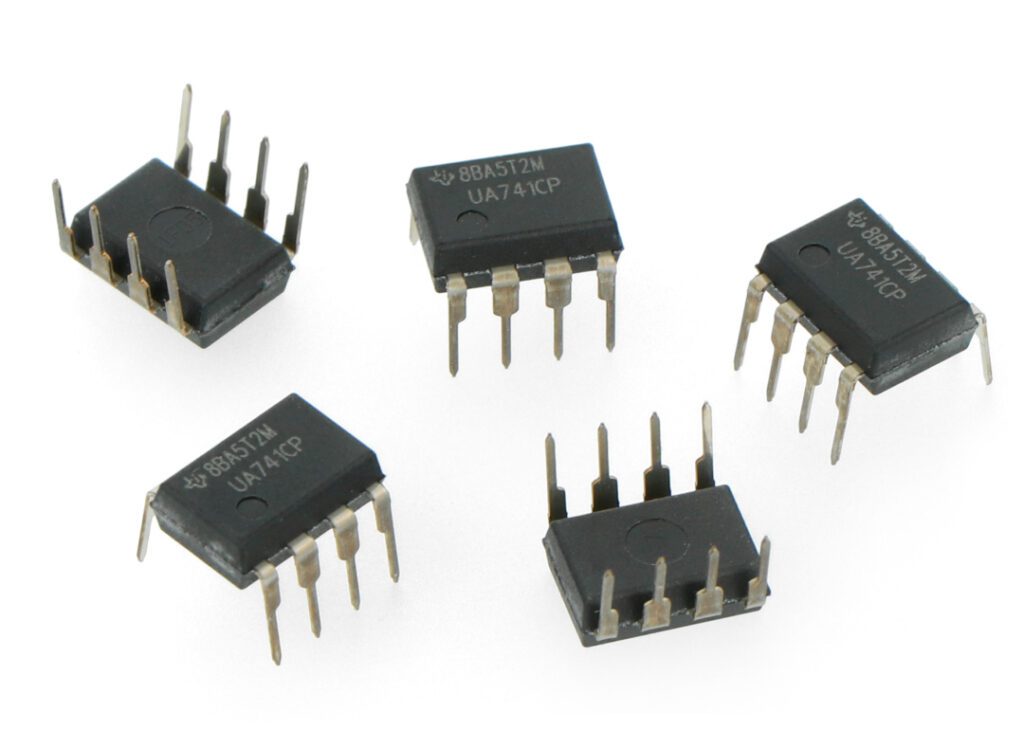Table of Contents:
An operational amplifier is an integrated circuit used for amplification, filtering and voltage stabilization. In addition, it is capable of rectifying alternating waveforms.
What is an operational amplifier?
Operational amplifiers
Are commonly used in analog electronics. Universal applicability, reliability and durability make these components an important part of numerous circuits found in electronic devices. They can perform various signal processing functions.
Operational amplifiers also referred to as opamps (the colloquial term comes from the English name of the component, operational amplifiers) are designed to allow signal processing between inputs. The amplifier is equipped with two inputs, a non-inverting one labeled + and an inverting one, which is -. In addition, the opamps have one built-in output. Characteristics of operational amplifiers include low output impedance and high input impedance. They come in various configurations (simulating, differentiating, inverting and non-inverting).
Operational amplifiers - construction
The operational amplifier
is composed of three main components. The first of these are bipolar or field effect transistors. The second is resistors, while the third element is capacitors. All components are integrated into a single structure, a monolithic design familiar from integrated circuits.
The built-in two inputs are responsible for reading the voltage between them. The next step is to amplify and send the changed signal directly to the output of the operational amplifier. Other components of the amplifier include power supply circuits, circuits responsible for temperature compensation, as well as elements protecting the monolithic structure from the effects of ESD (electrostatic discharge).
Technical parameters of operational amplifiers
The most important technical parameter of any operational amplifier is the gain level. Another key parameter is the operating voltage range, which determines the application of these components. Selected models of operational amplifiers for audio systems are designed to operate in a voltage range of 5 V to 15 V. Most often, these models are in THT housing, i.e. used for through-hole assembly. There are also models on the market in SMD (Surface Mount Device) housings suitable for surface mounting technology ( SMD ).
When selecting a particular model of operational amplifier, you also need to pay attention to the common mode rejection ratio ( CMRR ). This parameter is responsible for the ability of a particular amplifier model to suppress the voltage that occurs at the inputs. Other parameters include frequency response and input and output impedance.
Application of operational amplifiers
The use of operational amplifiers in electronics is very wide. Some of the most popular applications are described below. Opamps are commonly used in active filters to amplify a signal or change the frequency characteristics of a given circuit.
Another example is an inverting amplifier, a component responsible for amplifying the input signal while inverting the phase. In contrast, opamps in non-inverting amplifiers are designed to amplify the input signal without inverting the phase. The next use of an operational amplifier is as a voltage-to-current converter. The opamp has the ability to convert the input voltage to a proportional output current.
Other applications of operational amplifiers
Opamps are components of differential amplifiers, that is, circuits whose main task is to amplify the difference between two input signals. In function generators, on the other hand, an operational amplifier is used to produce various wave functions, including rectangular, triangular and sinusoidal waves.
An operational amplifier is a basic component of many electronic circuits. Versatile use, combined with the ability to perform a variety of tasks, makes these components found, among others. In medical apparatus, measuring devices and audio systems.
Popular models of operational amplifiers
Model NE5322 is a popular operational amplifier distinguished by its low noise level and an attenuation factor of 100 dB. A bandwidth of up to 10 MHz provides universal application. The IC is equipped with diodes, whose main task is to protect the inputs. The outputs, in turn, are protected by short-circuit protection elements. Good DC and AC performance makes the NE5532 often used, among others. In mixing consoles. It is also a key component in generators designed to produce test signals used in electroacoustics.
Another frequently used model is the operational amplifier
AB LM386
in a DIP8 housing for THT mounting. The item is equipped with one channel. It works with voltages ranging from 4 V to 12 V. Its high gain level of 325 mW makes it widely used in audio systems. In addition, it is used in DIY projects that generate or reproduce sound. A wide supply voltage range ensures compatibility with many microcontrollers, including Arduino.
In turn, the opamp
LM358P/N
is suitable for operation with supply voltages ranging from 3 V to as much as 32 V. The operational amplifier is equipped with two channels. The frequency response of 0.7 MHz provides universal application. The LM358P/N is distinguished by a voltage rise rate of 0.3 V/μs. The IC is enclosed in a popular DIP8 housing. It is designed for THT through-hole mounting.
How useful was this post?
Click on a star to rate it!
Average rating 0 / 5. Vote count: 0
No votes so far! Be the first to rate this post.




















